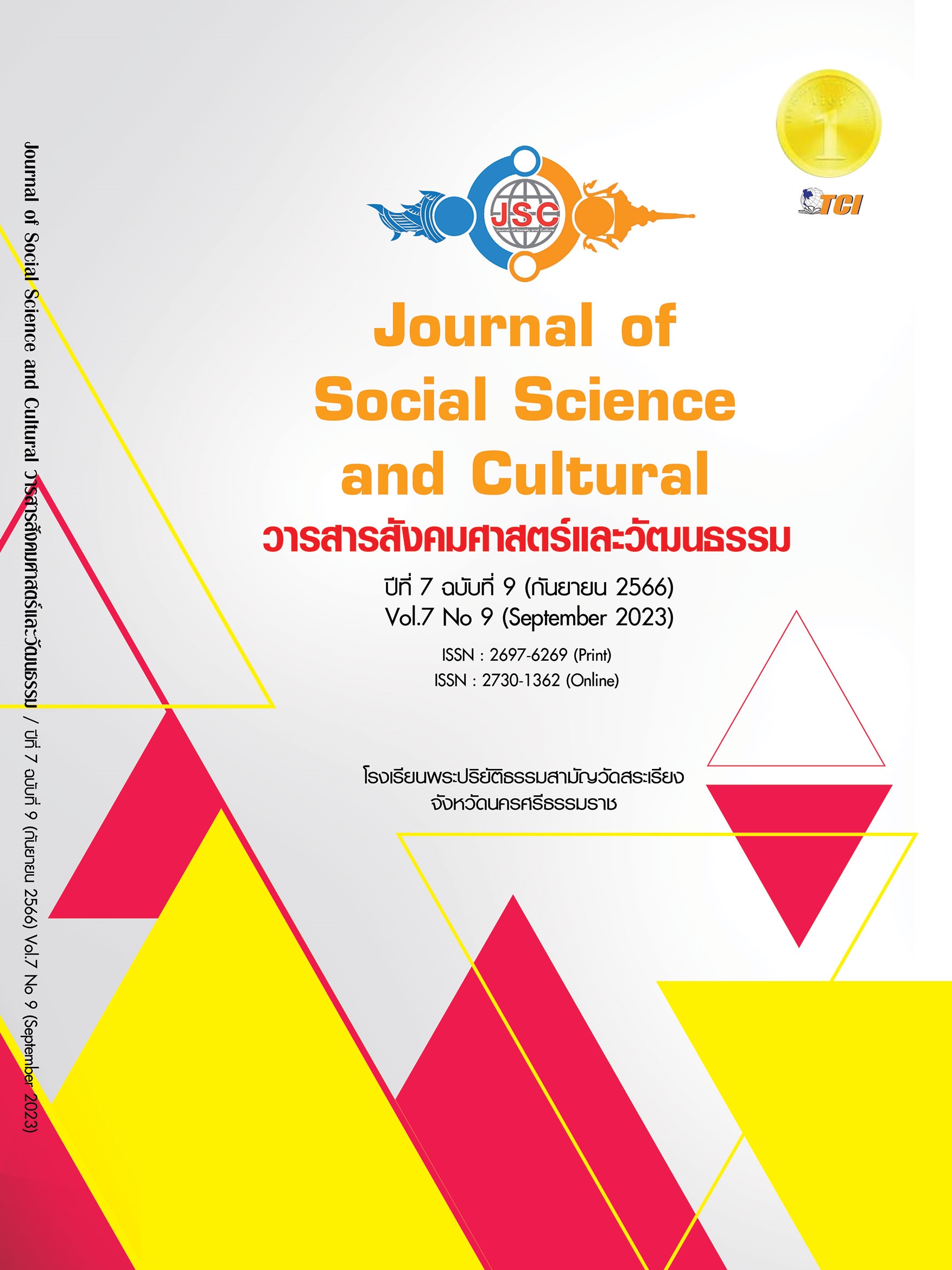DEVELOPING OCCUPATIONAL SKILLS LEARNING MODEL FOR CHILDREN AND YOUTH IN THE JUVENILE JUSTICE SYSTEM, PHRA NAKORN SI AYUTTHAYA PROVINCE
Main Article Content
Abstract
This research article aims to study the development of an occupational skills learning model for children and youth in the justice process in Phra Nakorn Sri Ayutthaya province. The research applies to action research methodology consisting of 4 processes: plan, action, observation, and reflection. Key informants of the research consist of 390 learners from 6 prisons in Phra Nakorn Sri Ayutthaya province and 25 lectures. Results of the research found the occupational skills model contains 4 main steps: 1) Deep listening to learners by asking about the skill desire. The lecturer should spend time on this process because it supports their attention within the class and also the relationship development between Lerner and the lecturer. 2) Provide lecture and design learning process which of active learning. This process should be prepared by the internal team because the project had a variety of classes so the internal team must communicate the planning and objective to outsource for archive together. 3) Doing process which is a process to develop learner study by themselves via their experience. The process focuses on individual abilities, and non-competition to others, but they can compare their skill by themselves. 4) Reflecting on ideas and improvement, the Lecturer should reflect and give positive advice. However, the research found that learners had reflections about future life plans and increased occupational skills. The change occurred in 4 areas: 1) positive attitude and active learning behavior. 2) Better relationship between learners and their friends. 3) The learning policy was changed to flexible learning time support. 4) Increase the quality of another prisoner.
Article Details
References
กรมพินิจและคุ้มครองเด็กและเยาวชน. (2565). รายงานสถิติคดีประจำปี พ.ศ. 2565. กรุงเทพมหานคร: ศูนย์เทคโนโลยีสารสนเทศ.
กานต์รวี บุษยานนท์. (2559). รูปแบบการสอนที่สอดคล้องกับการเรียนรู้ของสมอง การพัฒนาสมอง การเรียนรู้ Brain-Targeted Teaching Model: Brain development and Learning. วารสารศิลปศาสตร์ มหาวิทยาลัยอุบลราชธานี, 12(2), 159-176.
จิรทีปต์ ช่วยคง และศุภรา เจริญภูมิ. (2558). ยุทธศาสตร์ในการส่งเสริมสู่ความสำเร็จการศึกษาขั้นพื้นฐานของผู้ต้องขังในเรือนจำและทัณฑสถานเขต 9 อย่างเป็นรูปธรรม. วารสารศึกษาศาสตร์มหาวิทยาลัยทักษิณ, 15(1), 168-180.
จิรายุทธิ์ อ่อนศรี. (2561). การพัฒนาแนวคิดทฤษฎีการเรียนรู้สู่การปฏิบัติในศตวรรษที่ 21 ทฤษฎี การเรียนรู้ของ Bloom (Bloom’s Taxonomy). เรียกใช้เมื่อ 28 สิงหาคม 2566 จาก http://www.nwm.ac.th/nwm/wp-content/uploads/2018/07/การพัฒนาแนวคิดทฤษฎีการเรียนรู้สู่การปฏิบัติในศตวรรษที่-21.pdf
ทิพย์เกสร กำปนาท และคณะ. (2563). พฤติกรรมการเรียนรู้ด้านพุทธิพิสัยตามแนวคิดของบลูมที่ปรับใหม่. วารสารบัณฑิตวิจัย, 11(2), 1-9.
ประวิทย์ ฤทธิบูลย์ และคณะ. (2559). การศึกษาการใช้นาฏกรรมบำบัดต่อความเครียดของผู้ต้องขังชายแรกเข้าในทัณฑสถานวัยหนุ่มกลาง จังหวัดปทุมธานี. วารสารสถาบันวัฒนธรรมและศิลปะ มหาวิทยาลัยศรีนครินทรวิโรฒ, 17(2), 57-70.
ผู้ให้ข้อมูลท่านที่ 2. (14 กรกฎาคม 2566). รูปแบบการจัดการเรียนรู้ทักษะอาชีพสำหรับเด็กและเยาวชนในกระบวนการยุติธรรม. (ปิยวรรณ ทัศนาญชลี, ผู้สัมภาษณ์)
ผู้ให้ข้อมูลท่านที่ 3. (13 กรกฎาคม 2566). รูปแบบการจัดการเรียนรู้ทักษะอาชีพสำหรับเด็กและเยาวชนในกระบวนการยุติธรรม. (ณัฐชนา พุทธแสง, ผู้สัมภาษณ์)
ผู้ให้ข้อมูลท่านที่ 8. (19 กรกฎาคม 2566). รูปแบบการจัดการเรียนรู้ทักษะอาชีพสำหรับเด็กและเยาวชนในกระบวนการยุติธรรม. (ปิยวรรณ ทัศนาญชลี, ผู้สัมภาษณ์)
พระราชบัญญัติส่งเสริมการพัฒนาเด็กและเยาวชนแห่งชาติ พ.ศ. 2550 และที่แก้ไขเพิ่มเติม (ฉบับที่ 2). (2560). ราชกิจจานุเบกษา เล่ม 137 ตอนที่ 63 ก หน้า 1-34 (13 มิถุนายน 2560).
ภัทรภรณ์ วงษกรณ์ และคณะ. (2561). ผลของโปรแกรมการฝึกสติต่อความเครียดในผู้ต้องขัง. วารสารพยาบาลทหารบก, 19(ฉบับพิเศษ), 269-278.
รัศมี ศรีนนท์ และคณะ. (2561). การจัดการเรียนรู้เชิงรุกในยุคไทยแลนด์ 4.0. วารสารการบริหารการศึกษา มหาวิทยาลัยศิลปากร, 9(2), 331-343.
วราภรณ์ กันธิยะ และเพ็ญพักตร์ อุทิศ. (2565). ปัจจัยคัดสรรที่สัมพันธ์กับภาวะซึมเศร้าของผู้ต้องขังติดเมทแอมเฟตามีน. วารสารพยาบาลศาสตร์ จุฬาลงกรณ์มหาวิทยาลัย, 34(1), 78-91.
วารินท์พร ฟันเฟื่องฟู. (2562). การจัดการเรียนรู้ Active Learning ให้สำเร็จ. วารสารวไลยอลงกรณ์ปริทัศน์ (มนุษยศาสตร์และสังคมศาสตร์), 9(1), 135-145.
สัญสิริ อินอุ่นโชต์ และคณะ. (2564). การพัฒนากระบวนการจัดการเรียนรู้ตามทฤษฎีการสร้างความรู้ด้วยตนเองโดยการสร้างสรรค์ชิ้นงานร่วมกับแนวคิดการเรียนรู้แบบใช้กรณีศึกษาเป็นฐานเพื่อส่งเสริมความสามารถในการสร้างสรรค์นวัตกรรม. วารสารวิชาการ ครุศาสตร์สวนสุนันทา, 5(1), 74-85.
สำนักงานคณะกรรมการการศึกษาขั้นพื้นฐานกระทรวงศึกษาธิการ. (2562). แนวทางการนิเทศเพื่อพัฒนาและส่งเสริมการจัดการเรียนรู้เชิงรุก (Active Learning) ตามนโยบายลดเวลาเรียน เพิ่มเวลารู้. กรุงเทพมหานคร: หน่วยศึกษานิเทศ สำนักงานคณะกรรมการการศึกษาขั้นพื้นฐาน.
สุชาติ สมณะ และลัดดาวรรณ ณ ระนอง. (2560). ปมของผู้ต้องขังที่มีต่อภารกิจคืนคนดีสู่สังคม. วารสาร Veridian E-Journal Silpakorn University ฉบับภาษาไทย มนุษยศาสตร์ สังคมศาสตร์ และศิลปะ, 10(2), 1105-1114.
Bloom et al. (1956). Taxonomy of Educational Objectives, Handbook I: The Cognitive Domain. New York: David McKay Co Inc.
Chandio et al. (2017). Article Bloom's Taxonomy: Improving Assessment and Teaching- Learning Process. Journal of Education and Educational Development, 3(2), 203-221.
David, R. K. (2002). A Revision of Bloom’s Taxonomy an Overview, Theory into Practice. Theory Into Practice, 41(4), 212-218.


